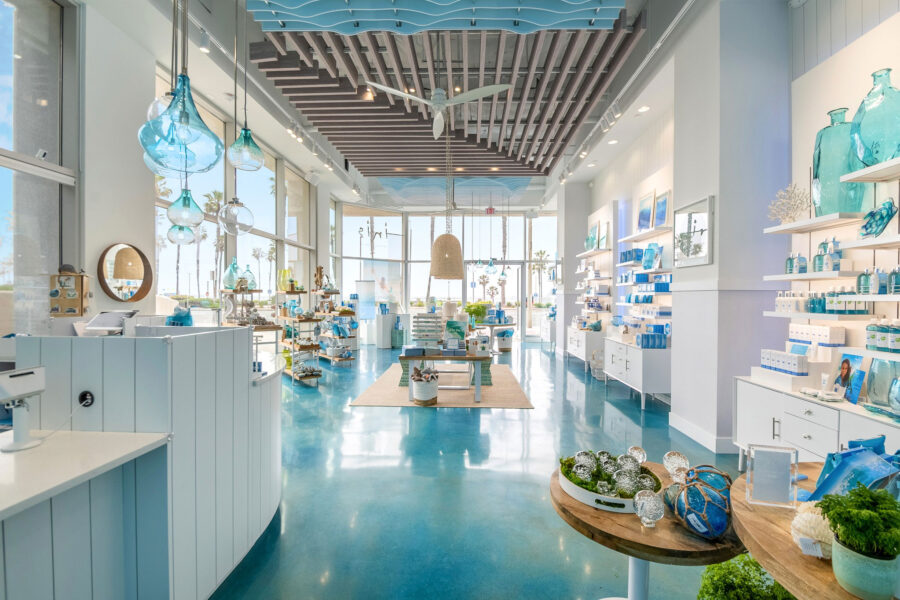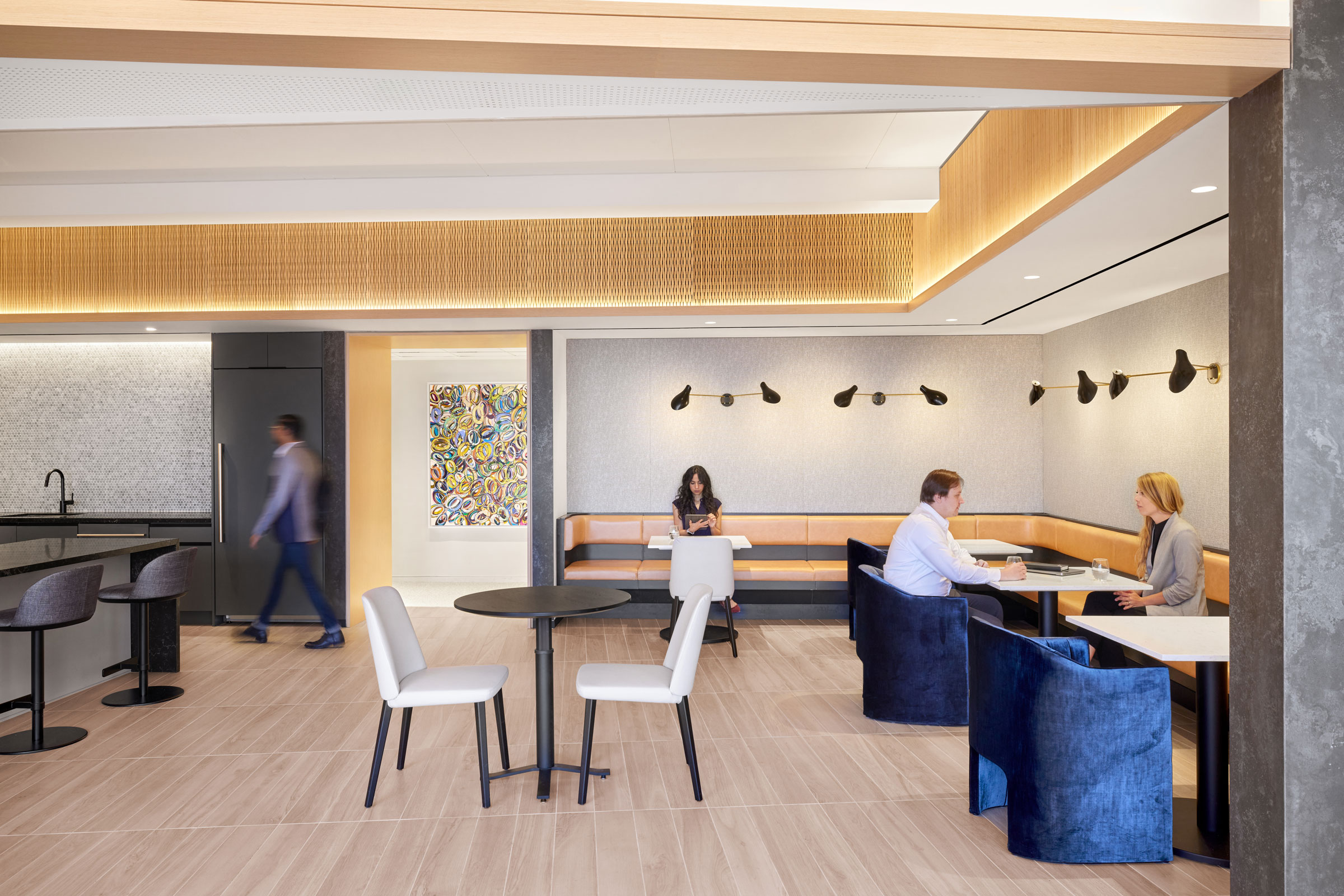Story at a glance:
- Acoustic dampening solutions are becoming increasingly popular as designers recognize the benefits to occupant well-being.
- Fabric Images’ solutions serve to create more comfortable spaces while incorporating unique and versatile design elements.
- Many of today’s architectural acoustic products are highly sustainable, with PET felt being made from recycled plastics.
To entice workers back into the office, building owners, operators, and tenants are placing a greater emphasis on amenities than ever before—with lifestyle perks like fitness centers, game rooms, and outdoor terraces receiving much of the media attention.
Yet there is a growing recognition in the industry that employee well-being, satisfaction, and productivity can benefit from simpler but more fundamental improvements to a workspace—with acoustic considerations now featuring prominently in interior design discussions.
“Acoustical solutions truly are one of the quintessential amenities,” says Arjav Shah, associate principal of corporate interiors at Perkins&Will. “They help us perform and function; they reduce sensory overload and enhance communication, especially in a work setting. Nobody wants to work in a noisy office.” The need for interior acoustic performance extends beyond the office typology. Designers of restaurants, retail, education, and health care spaces are increasingly incorporating acoustic decor into their plans as awareness of their benefits rises.
“The industry is really in this learning phase right now,” says Marco Alvarez, vice president of Fabric Images, one of the top manufacturers of design-centric architectural acoustic solutions. “A few years ago we were mainly seeing these included in a space when someone was doing a retrofit. Now designers are making it part of the environment from the beginning.”
Solving Common Pain Points
Acoustic decor addresses three main pain points in office settings. The first is the sound transfer between offices and conference rooms through walls. Another is the echo and reverberation that occurs in any enclosed space.
“That is especially important with the rise of hybrid meetings,” Shah says. “Video conferencing requires extremely clear sound so anyone who’s not in the room can understand what is being said.”
And third, the popular open office format presents its own challenges, where a conversation at a neighboring desk can interfere with your focus and cause distractions. “If employers want to improve the overall long-term productivity and well-being of their employees, investing in acoustics is required for any workplace.”
The same could be said for commercial settings. A cacophonous retail experience will likely drive customers away and hurt sales. Restaurants in particular aim to create a comfortable ambience that fosters conversation and leisure.
Acoustics on Display

Fi Interiors’ PET Acousti-fi felt mimics the look of wood. Photo courtesy of Fabric Images
That was part of the consideration when Fi Interiors, a studio of Fabric Images, was approached to support the design of a new celebrity chef’s restaurant at Chicago’s Navy Pier. The vision was one of a homestyle aesthetic—comfortable, casual, and warm.
One of the key elements tying the space together was the treatment of the ceiling. The project designers wanted the look of natural wood but understood that the sound reverberation off of a hard surface would disrupt the restaurant’s atmosphere.
The Fi Interiors team introduced the designers and contractor to Acusti-fi—their brand-approved acoustic PET felt—which they printed with an authentic wood grain. One of the challenges was avoiding the use of repeated textures or patterns, which would not occur in natural wood and would be noticeable from below.
To avoid this, the graphics team utilized a broad range of wood tones that could be mixed throughout the space to avoid repetition, making each panel look one-of-a-kind.
“Even professionals who work with the material daily can’t tell it’s not real wood,” Alvarez says. Two months after the restaurant’s opening, the client reported back on the positive impact the material has had on the sound quality of the space—as well as the number of compliments they receive on the look of the ceiling.
Ultimately everyone is affected differently by noise. “When thinking about neurodiversity as designers, it’s important to understand that people have different tolerances to noise,” Shah says. “Designing accordingly is one way a workplace can be made more inclusive.”
Unique Design Capabilities

Fi Interiors’ Acousti-fi felt is available in 21 stock colors. Photo courtesy of Fabric Images
As demand rises manufacturers of acoustic products are developing innovative ways of increasing acoustic comfort while leveraging materials to create captivating interior spaces, seamlessly blending form and function. Though simple fabric wall mounts are still common, more designers are stepping outside the box to build jaw-dropping architectural installations. “With the integration of this material into the space, an architect and designer can truly control the experience that much more,” Alvarez says. “As a partner to designers we’re constantly looking at architecture, at fashion, at the tech space, and nature. It’s almost limitless what can be created.”
Foam and cork are among the more common acoustic dampening materials. Fi Interiors’ solutions are made from PET felt—a porous material that absorbs sound energy—reducing what would otherwise reflect off hard surfaces like ceilings, walls, and floors.
We’re constantly looking at architecture, at fashion, at the tech space, and nature. It’s almost limitless what can be created.
PET felt is highly versatile and customizable, presenting designers with essentially a blank canvas that can be cut and molded into just about any shape or configuration. Beyond the physical form, Fi Interiors’ ability to print on the material without sacrificing sound absorption adds another level of personalization and expands the designer’s palette to include a wide array of bright, vivid imagery.
The versatility of today’s acoustic solutions is on full display at a high-end boutique perfumery that recently launched a flagship store in Huntington Beach, California. The design theme centered around the feel of a contemporary beach cottage and aimed to replicate “the energy of the sea.”
The space’s concrete floors, large windows, and high ceilings presented a challenge for the designers, knowing the resulting echo would harm the retail experience. The Fi Interiors team was commissioned to create a ceiling system that utilized the firm’s acoustic baffles and beams to absorb sound while seamlessly integrating the boutique’s branding into the experience.
The result is a uniquely molded suspended sculpture featuring undulating baffles printed in a smooth gradient of light blues that mimics the waves of the ocean, adding a finishing design touch to the bright and airy space. “This definitely helped create this relaxing, zen-like feeling that not only represented the brand well, but helped create an acoustic environment that is soothing,” Alvarez says.
Fi Interiors also offers Blaze Illuminated Art—a product collection that can serve as an artistic complement to any architectural acoustic solution. These work well in spaces that require a specific emphasis on artwork, branding, or messaging. “Whether mounted to a wall or used as a spatial divider, these products draw attention and provide added ambient light,” Alvarez says. “When you incorporate the illumination products with the felt, it looks absolutely stunning.”
Not all acoustic decor needs to be the highlight of a space’s design; in fact, some of the most effective solutions go unnoticed by those who experience them daily. “As a designer I’m often interested in designing acoustical solutions that almost disappear,” Shah says. “That’s much easier than it once was. The industry has come a long way, and there is a lot of product now that is very sophisticated.”
Shah recently designed a workplace for a financial services firm that wanted to line the walls of a boardroom with wood. To avoid acoustical challenges, the solution was to insert micro-perforations in the wood veneer, which was also backed with a one-inch sound absorbing substrate. “Those micro-perforations aren’t visible from a distance, so we were able to create a space that offered the warmth and character of wood, but with great acoustics,” Shah says.
Sustainable Solutions

Photo courtesy of Fabric Images
Though there is growing recognition in the design community that acoustic solutions improve interior spaces in terms of both performance and aesthetics, some environmentally conscious designers may be skeptical of utilizing additional materials on a project if it’s not completely necessary. Many of today’s acoustic solutions are highly sustainable—and the industry is only improving. Bamboo and cork, known as rapidly renewable materials, are highly effective for acoustic wall treatments. And the PET felt Fi Interiors uses is a minimum of 60% post-consumer content.
“PET felt repurposes material that would otherwise end up in landfills or oceans, helping to reduce the environmental impact of plastic pollution,” Alvarez says. The material is also known for its durability, offering a long service life and reducing the need for frequent replacements.
“I think we can do more to repurpose waste and turn it into acoustical solutions, which can ultimately help achieve LEED and other similar sustainability certifications,” Shah says.


